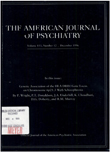"Just right" perceptions associated with compulsive behavior in Tourette's syndrome
Abstract
OBJECTIVE: Tourette's syndrome is a chronic disorder of childhood onset that is characterized by motor and phonic tics and a broad range of associated behavior including obsessive-compulsive symptoms. Less well appreciated are the sensory and other perceptually tinged mental phenomena associated with both tic and compulsive behavior. This cross- sectional study evaluated the "just-right" phenomena commonly associated with compulsive behavior in subjects with tic disorders. METHOD: A total of 134 subjects with tic disorders, aged 9 to 71 years, completed a questionnaire concerning their current and past tic symptoms. Subjects were also asked to describe their "just right" perceptions. The Yale-Brown Obsessive Compulsive Scale was used to assess severity of current obsessive-compulsive symptoms. RESULTS: Eight-one percent of the subjects with both Tourette's syndrome and obsessive-compulsive disorder (N = 31) and 56% of the subjects with Tourette's syndrome and obsessive-compulsive symptoms (N = 61) reported being aware of a need to perform compulsions until they were "just right." This awareness most commonly referred to visual or tactile (as opposed to auditory) features of the compulsive act or its consequences. Three-quarters of the subjects with these perceptions reported that they usually were aware of them immediately before or concurrently with the initiation of compulsions. CONCLUSIONS: While epidemiological studies of tic disorders and obsessive-compulsive disorder have yet to incorporate questions concerning "just right" perceptions, these results suggest that such perceptions may be commonplace in adolescent and adult subjects with both obsessive- compulsive disorder and tic disorders. They also implicate brain regions involved in the processing of sensorimotor information in the pathobiology of tic disorders.
Access content
To read the fulltext, please use one of the options below to sign in or purchase access.- Personal login
- Institutional Login
- Sign in via OpenAthens
- Register for access
-
Please login/register if you wish to pair your device and check access availability.
Not a subscriber?
PsychiatryOnline subscription options offer access to the DSM-5 library, books, journals, CME, and patient resources. This all-in-one virtual library provides psychiatrists and mental health professionals with key resources for diagnosis, treatment, research, and professional development.
Need more help? PsychiatryOnline Customer Service may be reached by emailing [email protected] or by calling 800-368-5777 (in the U.S.) or 703-907-7322 (outside the U.S.).



